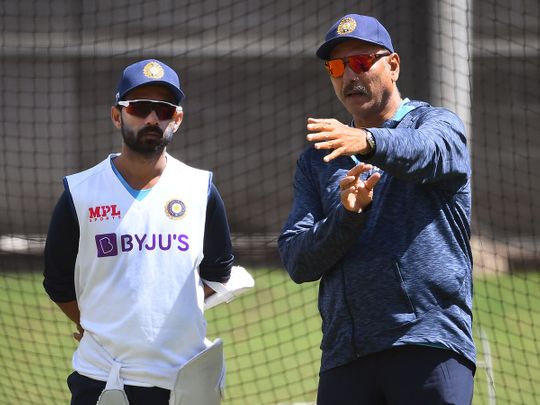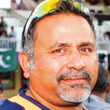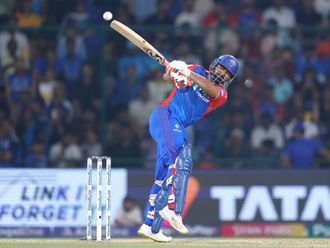
Kolkata: ‘‘Unreal, unimaginable,’’ these were the two typical Ravi Shastri replies, acknowledging a congratulatory message from Gulf News after Indian cricket team’s phenomenal Test series win against Australia in Brisbane last week.
At other times during his tenure - and the former Indian allrounder is already the longest serving Indian coach, it could have been treated as the usual hyperbole from him. However, there seems to be finally a sense of acceptance that the 57-year-old is not only about idle boasts and ‘‘tracer bullets,’’ one of his favourite expressions during his years as the TV pundit - but enough tactical nouss.
While the Young Turks of the Indian team like Rishabh Pant, Mohammed Siraj or Washington Sundar are basking in the glory on their return from Down Under, Shastri has predictably retreated to his farmhouse in Alibaug off Mumbai - the sense of satisfaction only too apparent after shepherding the Indian team to back-to-back Test series triumphs in Australia inside three years. True he has not exactly been an all-conquering coach, but as his current term is scheduled to end with the T20 World Cup in India in October, he seems to be leaving behind a tough act to follow.
Now in his fourth innings as the technical director or Head Coach of Indian team (if one includes the stop-gap role in 2007 when Greg Chappell stepped down after a disastrous ICC World Cup campaign), Shastri has had a long run - and the mandarins of the Indian cricket board would possibly have been inclined to look for a new incumbent. Well, not after this Australian tour - though there are quite a few tough challenges lined up along 2021 like the reciprocal Test series against England as well the World T20.
For all the heavy trolling that Shastri had been subjected to over the years, the biggest criticism about him was that of playing the ‘cheerleader’ - first for the then captain Mahendra Singh Dhoni and now Virat Kohli. The latter’s degree of comfort in working with Shastri is only too well known and helped Shastri win his job back from Anil Kumble in 2017.
The often laidback demeanour of Shastri in the dressing room environment, not to speak of his no-holds-barred love for good things in life often going viral on social media, questions had been often asked about the quantum of cricketing inputs actually provided by him over the years. While the man himself has mostly brushed aside the avalanche of criticism, India’s bowling coach Bharath Arun spilled the beans during his virtual press conference on Friday.
Arun, a self-effacing character who is credited in building up the awesome Indian pace arsenal, revealed that they had started plotting about Australia’s downfall since last July under the leadership of Shastri. “Ravi Shastri called me sometime in July and said we need to take the offside out of the Australians. We had our own analysis and we felt that most of the runs that Steve Smith and Marnus Labuschagne scored were because of cut, pull and on the offside. We took cue from the New Zealand attack. When they bowled to Smith, they just attacked his body and he felt very uncomfortable,” Arun revealed.
“Ravi called and said I want you to make a plan where we can eliminate their offside. We thought about it and decided that we will attack more on the straighter lines and have an on side field. It becomes very difficult for the batsman to consistently clear the on side field. That worked for us. The thought process started sometime in July and then when we discussed it with Virat, he bought the theory. We used the same thing in Adelaide and then Ajinkya was magnificent from Melbourne. The bowlers adjusted to that beautifully,” Arun revealed.
Acknowledging Shastri’s idea of holding back their net bowlers like T.Natarajan or Shardul Thakur after the white ball series, Arun said: ‘‘I think in the COVID times, it was a good move by Ravi Shastri to hold back all the net bowlers as well. After the ODI series, most of them were supposed to go back, but somehow, we thought that in case anything happens to a player, it will be impossible for anyone to come because of restrictions. We said we will manage with everyone and since they were with us for long, it was possible for them to understand what was demanded of them to be successful in Australia.”

Ravi Shastri called me sometime in July and said we need to take the offside out of the Australians. We had our own analysis and we felt that most of the runs that Steve Smith and Marnus Labuschagne scored were because of cut, pull and on the offside. We took cue from the New Zealand attack.
Despite young opener Prithvi Shaw being the butt of all criticism after his twin failure at Adelaide, Shastri reportedly spent hours working with him, got his sessions recorded and would later discuss the finer points with Shaw. There were also reports about Shastri realising that Mayank Agarwal was overthinking and overdoing things during net sessions and told him to relax and take a break. He was concerned about players picking injuries during nets sessions and at one point, stopped Cheteshwar Pujara from batting as he feared that the batsman might aggravate an existing injury.
It’s not that Shastri didn’t make his share of mistakes as coach. He had dropped the likes of Pujara and Ajinkya Rahane during Test series in England and South Africa. He has tried to make Hardik Pandya into a Test all-rounder without success, pick Kuldeep Yadav for a Test under cloudy conditions in England, failed to find the right batting combination that cost India dearly at the 2019 World Cup.
He still does not have a Test series win in England, South Africa and more recently New Zealand on his resume. But for once, he deserves a share of the credit for masterminding the heist Down Under - a happy hunting ground for him both as a player and now coach!








